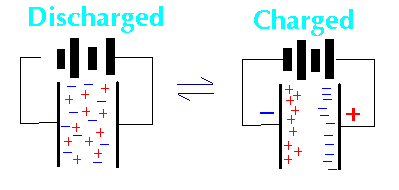|
Unlike batteries, which store energy chemically,
capacitors store energy as an electrostatic field. Typically, a battery is
known for storing a lot of energy and little power; a capacitor can provide
large amounts of power, but low amounts of energy. A capacitor is made of two
conducting plates and an insulator called the dielectric, which conducts
ionically, but not electrically. In a capacitor,
Ecap = qV = ½CV2
where the capacitance, C, is directly proportional to the
surface area of the plates and inversely proportional to the distance between
them.

So in other words, as the plate surface area increases and
the distance between the plates decreases, the energy you can store in a
capacitor increases. Normal every-day capacitors have capacity on the orders of
millifarads per cubic foot. Aluminum electrolytics are about a farad per cubic
foot. But for useful energy storage we need farads per cubic inch. That is
where supercapacitors come in.
First let's see how clever we can get to obtain a big
surface area in a small volume. Imagine a polymer foam cleaning sponge. It has
a tremendous amount of surface area in a small area because of all the
crenulations (OK, nooks and crannies). Now, put it in a furnace, excluding the
oxygen and bake it until only the carbon is left. You now have a conductive
carbon surface with an incredible surface area in a small volume.
But to get a high capacitance there has to be two plates.
You can't just go in there and create complimentary surface as the other
electrode—or can you? Yes, just fill it with a conductive liquid (e.g., an
aqueous acid or salt solution). The last thing you need is an ultra-thin
insulator on the carbon. Ultra thin to get high capacitance, and insulator so
the carbon and the liquid don't short out. This is also easy, you can
electrochemically deposit an insulator on the carbon surface (or
electrochemically deposit something that could be turned into an insulator upon
baking).
Now attach one electrode to the carbon, one to the liquid,
and you can have a capacitor that can have Farads of capacitance per cubic
inch. Very nice.
Most practical supercapacitors have low voltage (2 to 5
V—remember that insulator is ultra-thin and so can break down at low
voltages), which is a problem for energy storage, since the stored energy is
proportional to the square of the voltage. Also, conduction through an ionic
liquid is slow, so these capacitors cannot be discharged quickly compared with
standard capacitors, but can be discharged very quickly compared to
batteries!
Typical numbers for capacitors and batteries are given
below:
| device |
volumetric
energy
density
Wh/L |
power
density
W/L |
number of
charge/discharge
cycles |
discharge
time
s |
| batteries |
50-250 |
150 |
1 - 103 |
> 1000 |
| capacitors |
0.05 - 5 |
105 - 108 |
105 - 106 |
<1 |
Supercapacitors have several advantages over batteries:
they can experience virtually indefinite number of cycles (charging and
discharging), they are maintenance free, they work well in high-rate discharge,
they recharge quickly, and they have no negative environmental impact. Their
disadvantages are low energy density, linear voltage drop during discharge, and
high cost. |
